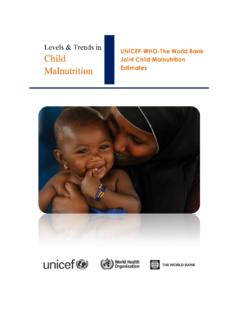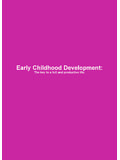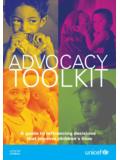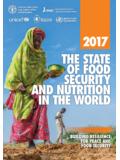Transcription of EMERGENCY RESPONSE FRAMEWORK - WHO
1 EMERGENCY . RESPONSE . FRAMEWORK . WHO Library Cataloguing-in-Publication Data EMERGENCY RESPONSE FRAMEWORK (ERF).. planning. medical services. Health Organization. Health Organization. ISBN 978 92 4 150497 3 (NLM classification: WB 105). World Health Organization 2013. All rights reserved. Publications of the World Health Organization are available on the WHO web site ( ) or can be purchased from WHO Press, World Health Organization, 20 Avenue Appia, 1211 Geneva 27, Switzerland (tel.: +41 22 791 3264; fax: +41 22 791 4857; e-mail: Requests for permission to reproduce or translate WHO publications whether for sale or for non-commercial distribution should be addressed to WHO Press through the WHO web site ( copyright_form/ ). The designations employed and the presentation of the material in this publication do not imply the expression of any opinion whatsoever on the part of the World Health Organization concerning the legal status of any country, territory, city or area or of its authorities, or concerning the delimitation of its frontiers or boundaries.)
2 Dotted lines on maps represent approximate border lines for which there may not yet be full agreement. The mention of specific companies or of certain manufacturers' products does not imply that they are endorsed or recommended by the World Health Organization in preference to others of a similar nature that are not mentioned. Errors and omissions excepted, the names of proprietary products are distinguished by initial capital letters. All reasonable precautions have been taken by the World Health Organization to verify the information contained in this publication. However, the published material is being distributed without warranty of any kind, either expressed or implied. The responsibility for the interpretation and use of the material lies with the reader. In no event shall the World Health Organization be liable for damages arising from its use. WHO's EMERGENCY . Printed in Switzerland RESPONSE . FRAMEWORK EMERGENCY . RESPONSE . FRAMEWORK . EMERGENCY . RESPONSE . FRAMEWORK . Contents Abbreviations 6.
3 Executive summary 7. Introduction 9. WHO's obligations under the International Health Regulations (2005) 9. WHO's obligations to the Inter-Agency Standing Committee (IASC) 10. WHO's commitment to its leadership role in EMERGENCY RESPONSE 11. The purpose of the EMERGENCY RESPONSE FRAMEWORK 12. Critical assumptions for successful implementation of the ERF 13. WHO's core commitments in EMERGENCY RESPONSE 14. PART 1 Determining if an event has public health impact 15. Monitoring events 15. Triggers for event verification and event risk assessment 15. Event verification and event risk assessment 15. Using results from event risk assessments 16. Recording events 17. Closing events 17. PART 2 WHO's internal grading process for emergencies 18. Purpose and parameters of grading 18. Grade definitions 19. Grading process 20. Removal of grade 22. PART 3 WHO's Performance Standards in EMERGENCY RESPONSE 23. WHO's Performance Standards 23. Application of WHO's Performance Standards 25. Reporting on Performance Standards 26.
4 WHO'S. EMERGENCY . RESPONSE . FRAMEWORK 4. PART 4 WHO's four critical functions in EMERGENCY RESPONSE 27. The four critical functions 27. Delivering on the four critical functions 27. Support to the four critical functions from the international level in emergencies 28. PART 5 WHO's Global EMERGENCY Management Team 29. The purpose and composition of the GEMT 29. The role of the GEMT in EMERGENCY RESPONSE 29. PART 6 Essential policies for optimizing WHO's EMERGENCY RESPONSE 31. Surge policy 31. Health EMERGENCY Leader policy 32. No-regrets policy 33. Part 7 WHO's EMERGENCY RESPONSE Procedures 35. Table 1. Leadership 36. Table 2. Information 42. Table 3. Technical expertise 46. Table 4. Core services 48. Annexes 50. Annex 1. ERF grading flowchart 50. Annex 2. Country-level timeline for RESPONSE 52. Annex 3. WHO's obligations under an IASC Level 3 EMERGENCY 54. Annex 4. WHO's Performance Standards in protracted emergencies 56. Annex 5. WHO's commitment to institutional readiness 57. Annex 6.
5 WHO's commitment to EMERGENCY risk management 58. WHO's EMERGENCY . RESPONSE . FRAMEWORK 5. Abbreviations CERF Central EMERGENCY RESPONSE Fund ERF EMERGENCY RESPONSE FRAMEWORK ERT EMERGENCY RESPONSE Team (country level). ERP EMERGENCY RESPONSE Procedure EST EMERGENCY Support Team (international level). ESTL EMERGENCY Support Team Leader GEMT Global EMERGENCY Management Team GEMT-R Global EMERGENCY Management Team for RESPONSE GEN Global EMERGENCY Network HCC Health Cluster Coordinator HCT Humanitarian Country Team HL Health EMERGENCY Leader HQ WHO headquarters HWCO Head of WHO Country Office IASC Inter-Agency Standing Committee IHR International Health Regulations (IHR) (2005). RO WHO regional office WCO WHO country office WRC WHO RESPONSE Coordinator WHO'S. EMERGENCY . RESPONSE . FRAMEWORK 6. Executive summary WHO's Member States face a broad range of emergencies resulting from various hazards and differing in scale, complexity and international consequences. These emergencies can have extensive political, economic, social and public health impacts, with potential long-term consequences sometimes persisting for years after the EMERGENCY .
6 They may be caused by natural disasters, conflict, disease outbreaks, food contamination, or chemical or radio-nuclear spills, among other hazards. They can undermine decades of social development and hard-earned health gains, damage hospitals and other health infrastructure, weaken health systems and slow progress towards the Millennium Development Goals (MDGs). Preparing for and responding effectively to such emergencies are among the most pressing challenges facing the international community. WHO has an essential role to play in supporting Member States to prepare for, respond to and recover from emergencies with public health consequences. WHO also has obligations to the Inter-Agency Standing Committee (IASC) as Health Cluster Lead Agency, to the International Health Regulations (2005) and to other international bodies and agreements related to EMERGENCY RESPONSE . The purpose of this EMERGENCY RESPONSE FRAMEWORK (ERF) is to clarify WHO's roles and responsibilities in this regard and to provide a common approach for its work in emergencies.
7 Ultimately, the ERF requires WHO to act with urgency and predictability to best serve and be accountable to populations affected by emergencies. First, the ERF sets out WHO's core commitments in EMERGENCY RESPONSE which are those actions that WHO is committed to delivering in emergencies with public health consequences to minimize mortality and life-threatening morbidity by leading a coordinated and effective health sector RESPONSE . Second, the ERF elaborates the steps WHO will take between the initial alert of an event and its eventual EMERGENCY classification, including event verification and event risk assessment. Third, the ERF describes WHO's internal grading process for emergencies including the purpose of grading, the definitions of the various grades, the criteria for grading, and the steps to remove a grade. Fourth, this paper describes WHO's Performance Standards for EMERGENCY RESPONSE : specific deliverables with timelines for completion that are used by WHO to WHO's measure its performance.
8 EMERGENCY . RESPONSE . FRAMEWORK 7. Fifth, the ERF outlines WHO's four critical functions during EMERGENCY RESPONSE : leadership, information, technical expertise and core services. Sixth, the ERF states the role of WHO's Global EMERGENCY Management Team (GEMT) during EMERGENCY RESPONSE , particularly related to the optimal use of Organization-wide resources, the monitoring of the implementation of relevant procedures and policies, and the management of WHO's internal and external communications. Seventh, the ERF outlines WHO's EMERGENCY RESPONSE Procedures (ERPs) that specify roles and responsibilities across the Organization to deliver on the four critical functions and the Performance Standards. Finally, three essential EMERGENCY policies which will optimize WHO's RESPONSE are detailed: the surge policy, the Health EMERGENCY Leader policy and the no- regrets policy. At the end of the document there are six complementary annexes. Annex 1 provides a flow chart of the grading process and Annex 2 a country-level timeline during EMERGENCY RESPONSE .
9 Annex 3 states WHO's obligations under an Inter-Agency Standing Committee Level 3 EMERGENCY ; Annex 4 sets out WHO's Performance Standards in protracted emergencies; Annex 5 defines WHO's commitment to institutional readiness; and Annex 6 defines WHO's commitment to EMERGENCY risk management. WHO'S. EMERGENCY . RESPONSE . FRAMEWORK 8. Introduction Over the decade 2001 2010, an average of more than 700 natural and technological emergencies occurred globally every year, affecting approximately 270 million people and causing over 130 000 deaths Twenty-five per cent of these emergencies, and 44 per cent of these deaths, occurred in less developed countries with limited capacities to prepare for and respond effectively to emergencies. These statistics do not include the high levels of mortality and morbidity associated with conflict-related emergencies. According to the World Bank, over billion people one quarter of the world's population live in countries affected by violent These populations suffer from the consequences of societal disruption and increases in mortality and morbidity due to infectious diseases, acute malnutrition, trauma and complications from chronic diseases.
10 Of the 20 countries with the highest childhood mortality rates in the world,3 at least 15 have experienced civil conflicts during the past two decades. Of the 10 countries with the highest ratios of maternal mortality,2 nine have recently experienced conflict. Over the same time period, risks to public health have increased due to globalization, and international travel and trade. Such risks might be transmitted by people ( SARS, influenza, polio, Ebola), goods, food, animals ( zoonotic disease), vectors ( dengue, plague, yellow fever), or the environment ( radio-nuclear releases, chemical spills or other contamination). In all types of emergencies, the poorest and most vulnerable people suffer disproportionately. These negative impacts are complicated by the enormity of the resulting economic costs, averaging over US$100 billion per year. The appropriate and timely management of these risks requires effective national and international capacities, intersectoral collaboration, the promotion of equity, the protection of human rights, and the advancement of gender equality.














